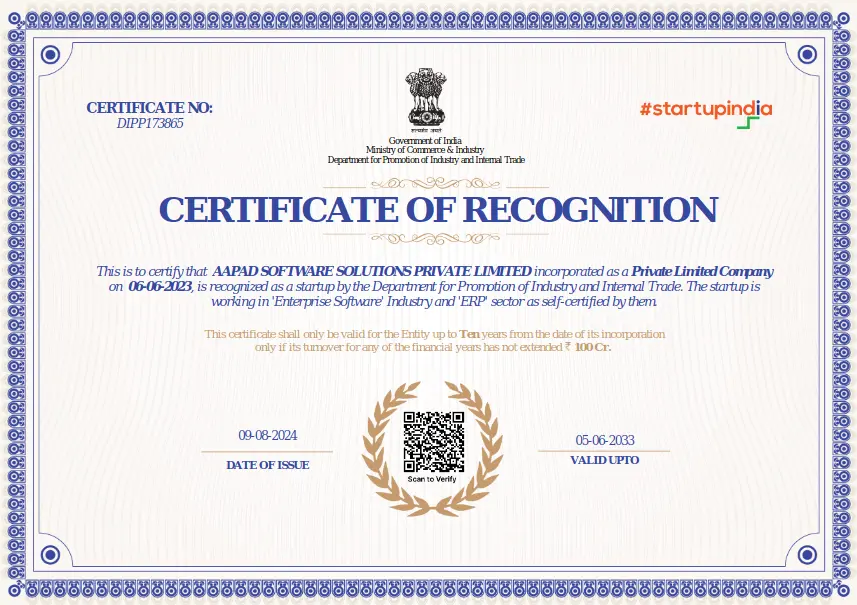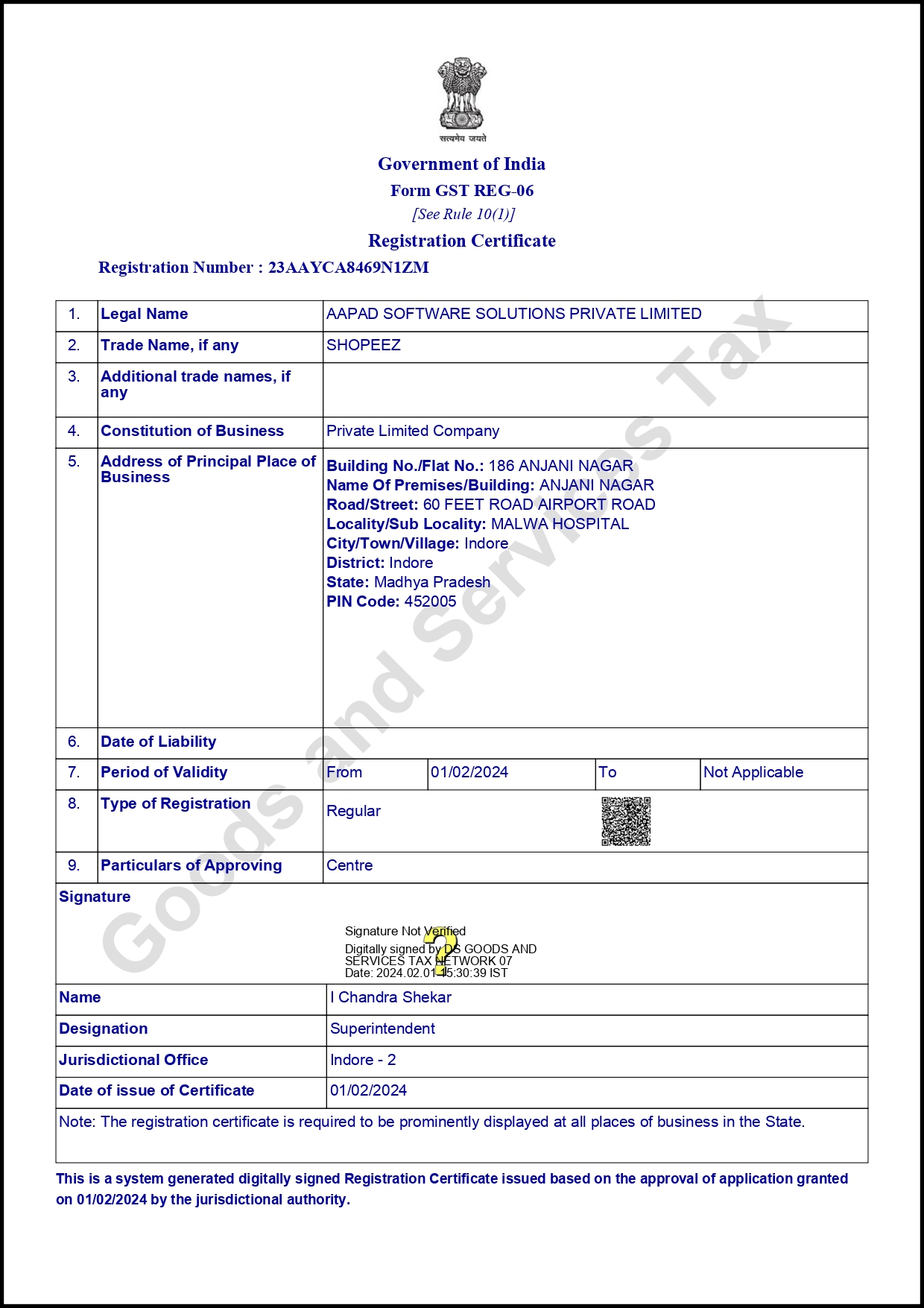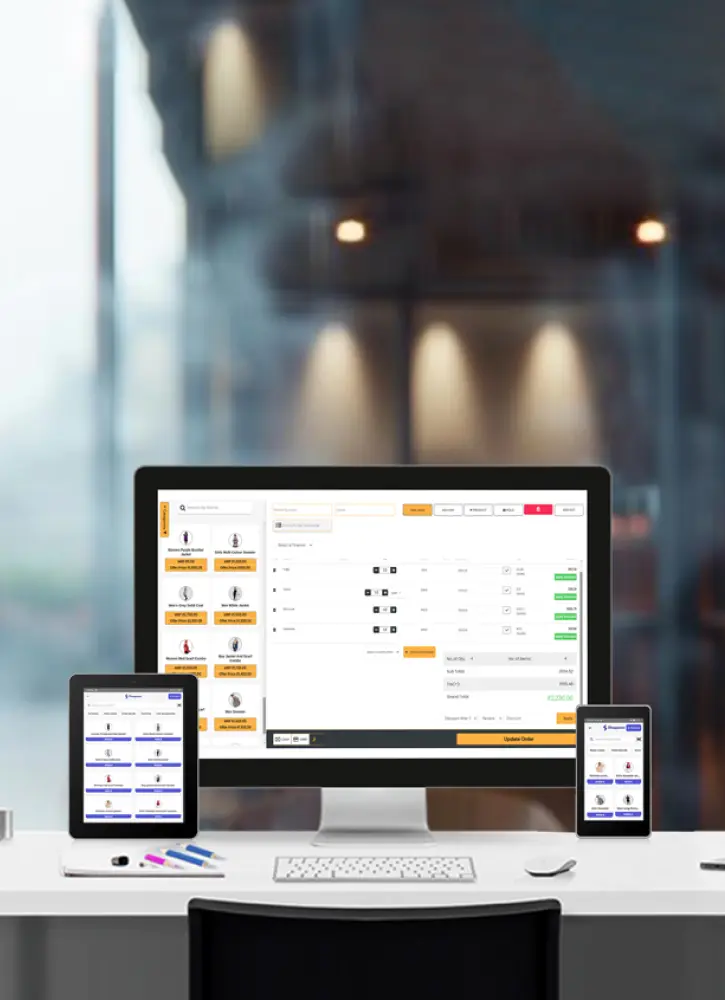
27-08-2024
What is an Invoice? And How to create it?
An invoice is a document that is given by the seller to the buyer for the collection of payment. It outlines the details of the cost of the product
Explore How Generating Invoices Can Strengthen Your Brand Presence in the Market
Invoices are a crucial part of the business that help in tracking and recording transactions accurately. Without a clear record of purchases and sales, managing finances becomes complex and challenging. Inaccurate or incomplete records can lead to difficulties in assessing profit and loss, potentially causing significant financial and operational issues.
Effective invoicing and billing software is crucial for maintaining organized and transparent financial records. It simplifies the management of transactions, ensuring that businesses can generate accurate financial statements and track were money flows most effectively.
If you're interested in learning how a well-structured invoice can enhance trust between you and your customers or other businesses, it's important to understand the meaning and purpose of invoices. Knowing how to create them properly and recognizing their significance can greatly benefit your business operations.
For those who find invoicing challenging, Shoppeez Invoicing and Billing Software offers a streamlined solution. With its user-friendly interface and impressive templates, Shoppeez makes it easy to generate multiple invoices efficiently, helping you manage your billing with ease and professionalism.
What is an Invoice?
An invoice is a document that is given by the seller to the buyer for the collection of payment. It outlines the details of the cost of the product purchased, the price at which the product is sold, unit prices, any discounts or offers availed by the buyer, descriptions of the goods, GST rates, terms and conditions of payment, and other relevant information. This invoice serves as proof of the transaction and provides a formal record that both parties can use for financial and accounting purposes.
Furthermore, these invoices are of different kinds, and they all are used for different purposes. The type of invoice a company uses totally depends on the work they deal with. Invoices are of 7 types, let’s discuss each one and understand its use.
What are the Types of Invoices?
1. Proforma Invoice
A proforma invoice is like a preliminary document which is sent to the buyer mentioning all the details of the products or services being offered. It includes information such as quantities, weight, terms and conditions, and the prices at which the goods are to be sold. Apart from standard invoice, a proforma invoice is not a request for payment. Instead, it serves as a detailed estimate designed to ensure clarity and avoid any misunderstandings in the transaction.
The primary purpose of a proforma invoice is to give the buyer a clear view of pricing estimates and delivery terms before the final transaction takes place. This helps build transparency between both parties, ensuring that everyone is on the same page regarding the terms and conditions of the sale.
2. Interim Invoice
Interim invoices, also known as progress invoices or progress bills, are used by businesses to request partial payments for work completed in stages. Typically employed in large projects or contracts, these invoices ensure that the business maintains a steady cash flow throughout the duration of the project. By issuing interim invoices, a company can secure partial payments as milestones are achieved, which supports financial stability and helps manage the project's financial aspects more effectively. This approach provides clarity and ensures that the business is compensated for ongoing work, contributing to a healthier overall financial management strategy.
3. Recurring Invoice
As the term "recurring" implies, recurring invoices are those issued repeatedly for the same goods or services over time. When a customer regularly orders the same products or services, a recurring invoice simplifies the billing process by generating and sending the same invoice periodically. This type of invoice maintains consistent details—such as prices, product descriptions, client information, and quantities—ensuring that everything remains unchanged with each billing cycle. The invoice is automatically sent to the same recipient at their address, streamlining the billing process and reducing administrative effort.
4. Final Invoice
When a project is completed, the final invoice is issued to the client, marking the end of all financial transactions related to the work. This final invoice is the last bill the client receives and includes a comprehensive summary of all charges, adjustments, and any additional costs incurred throughout the project. Upon receipt and payment of this invoice, the project is officially concluded, and both parties can finalize all remaining details to formally close the contract. This final step ensures that all financial matters are settled, and the project is properly wrapped up.
5. Collective Invoice
For small-scale businesses handling numerous small transactions, preparing a collective invoice can be a highly efficient solution. Instead of issuing separate invoices for each transaction, a collective invoice consolidates all transactions into a single document with a clear summary of each individual entry. This approach simplifies the payment process by making it easier for both parties to track and manage costs. The use of a collective invoice in invoicing and billing software helps reduce administrative burden, enhances clarity, improves cash flow, and minimizes discrepancies by providing a comprehensive overview of all transactions in a combined format. This streamlined approach benefits both the business and its clients, ensuring smoother and more transparent financial operations.
6. Credit Invoice
A credit invoice, also called a credit memo, is issued by the buyer to the seller to correct an error on the original invoice or to request a discount or refund. This document formally requests a reduction in the amount owed, effectively providing credit to the buyer. The credit amount can be used to offset future purchases or balance out the current account, ensuring that the financial records are accurate, and that the buyer is appropriately credited for any overcharges or errors.
7. Debit Invoice
A debit invoice, also known as a debit memo, is issued by the buyer to the seller to address discrepancies in the original invoice. This type of document is used when there are errors or inaccuracies in the billed amounts, such as undercharges or incorrect pricing. Essentially, a debit invoice acts as a formal request for an adjustment to correct these issues and ensure that the financial records accurately reflect the intended transaction. It helps maintain transparency and accuracy in the billing process by addressing and rectifying any discrepancies.
How are Invoices Created?
A Step-By-Step Guide
Creating well-designed invoices is a professional way for businesses to showcase their brand and establish a valuable identity. A thoughtfully crafted invoice not only reflects your brand's professionalism but also helps in retaining customers by ensuring clarity and accuracy. On the flip side, a poorly designed invoice can lead to confusion and errors, making it difficult for customers to understand the transactions. Therefore, it’s essential for businesses to appreciate the art of invoicing and recognize its importance in maintaining a positive brand image. Several key factors must be considered when creating invoices to effectively build and reinforce a strong brand identity.
1. Brand Your Invoices
Imagine how much more impactful your invoices could be if they featured your business logo, colors, and fonts. Customizing your invoices in line with your brand not only makes them more attractive but also reinforces your brand identity. When an invoice reflects your company’s values and aesthetics, it adds a touch of professionalism and makes your brand more memorable. Thoughtful branding makes your invoices stand out, creating a lasting impression on your clients and highlighting the quality and consistency of your business.
Pro Tip: To build your brand, make sure your social media and website use the same fonts, colors, and logo. Consistently sharing posts and blogs with these elements will help customers easily recognize and connect with your brand.
2. Add a Professional Header
Including a professional header at the top of your invoice sets a polished tone right from the start. Begin with your company’s logo, followed by your business address and contact information. This establishes your brand’s identity and provides essential details for easy communication.
Next, add the client’s details to clearly indicate who the invoice is for. If applicable, mention your business's registration number and tax ID, especially if you collect sales tax. This information confirms that your business is legally registered and compliant with tax regulations. Overall, a well-organized header not only enhances the professional appearance of your invoice but also ensures that all necessary legal and contact details are clearly presented.
3. Label ‘Invoice’ Word
To make it easy to identify, center the heading "Invoice" at the top of the document. Additionally, assign a unique identification number to each invoice to facilitate tracking. Choose a numeric system for invoice numbering that suits your business needs, helping to prevent confusion and errors. As businesses often handle multiple projects, adding specific project information to the invoice can further aid in distinguishing and organizing different invoices, making it simpler to manage and reference them as needed.
4. Day/Date Information
Maintaining accurate records of each transaction is vital for assessing a company's financial growth and preparing precise reports. Invoices play a crucial role in this process, so it's important to include specific details such as the date, time, and day of the transaction. This information helps resolve any potential confusion that might arise in the future. Invoices serve as proof that goods have been delivered and revenue has been earned by the business. Additionally, having detailed date and time information aids businesses in tracking payments and ensuring accurate financial records.
5. Description of Goods & Services
When preparing an invoice, it’s crucial to include a detailed description of the goods or services being billed. This includes specifying the price of each item or service, the quantity provided, any discounts applied, the per unit rate, and the GST rates applicable. Additionally, the total amount payable by the customer should be clearly stated. Such thorough descriptions not only help businesses keep accurate records of their inventory, sales, and revenue but also reduce the likelihood of misunderstandings or errors between the parties involved. By ensuring clarity in the invoice, businesses can maintain transparency and facilitate smoother transactions.
6. Tax and Payment Details
Your invoicing and billing software plays a crucial role in managing various tax rates applicable to different items, which can vary by state. It’s essential to include the applicable tax rate for each product according to state guidelines and government rules on your invoices.
Today, businesses offer multiple payment options, including credit cards, debit cards, UPI, bank transfers, and cheques. Ensure your invoices clearly record how the payment was made or is expected to be made by the customer.
Additionally, your invoices should include details such as ‘last payment penalties,’ ‘currencies accepted,’ terms and conditions, and a transparent statement of refund and return policies. This ensures that every transaction is clear and transparent.
Shoppeez invoicing software simplifies this process by offering customizable invoice templates. Choose from a variety of free invoices templates, add your business logo, and input the necessary details. With Shoppeez, you can easily download these templates and share invoices quickly using our e-invoicing feature. If you’re new to e-invoicing, we offer full support to guide you through what it means.
What is the meaning of E-Invoicing
E-invoicing is the process of creating and sharing invoices electronically rather than using traditional paper methods. This digital format helps businesses cut down on paper usage and streamline their invoicing processes. E-invoices can be generated quickly and easily from various platforms, including software applications, desktops, and mobile devices.
With advancements in technology, e-invoicing simplifies invoice management by minimizing manual data handling and speeding up transaction processing. It also allows for real-time verification against tax authorities, ensuring compliance and accuracy. Additionally, e-invoicing integrates seamlessly with ERP (Enterprise Resource Planning) systems, further enhancing precision and efficiency in managing business finances.
Conclusion
Invoicing software is essential for businesses looking to streamline and accelerate their invoicing processes. It’s not just about automating billing; it’s also about gaining better control over finances, inventory, and sales operations. By using invoicing and billing software, companies can not only speed up their billing but also enhance their brand identity by reflecting their professionalism and values.
Shoppeez invoicing software stands out as a top choice with its advanced e-invoicing features. It ensures a faster and more secure invoicing process, helping businesses manage their invoicing needs efficiently while showcasing their commitment to quality and reliability.
Check out now : https://shoppeez.com/demo_requests/new

29-11-2024
What is Balance Sheet? How to understand Balance Sheet of a Company?
Balance Sheet is a financial statement that provides a snapshot of a company's financial position...
Read More
21-11-2024
What is the Difference Between Debit Note and Credit Note in GST?
A debit note in GST is a document issued by a customer to inform the vendor about an amount that has been debited from their accounts.
Read More
12-11-2024
Complete Guide for the Best Retail Billing Software
Discover top retail billing software to enhance efficiency, sales, and customer experience.
Read More
11-11-2024
Top 5 Benefits of Retail POS Software for Supermarket & Hypermarket
Discover how retail POS software India can transform your supermarket or hypermarket operations. From streamlined transactions to enhanced inventory management.
Read More
27-08-2024
What is an Invoice? And How to create it?
An invoice is a document that is given by the seller to the buyer for the collection of payment. It outlines the details of the cost of the product
Read More
23-08-2024
The Advantages of Pharmacy Billing Software
Pharmacy billing software is essential for medical stores to boost efficiency and streamline checkout processes, which helps reduce wait times for customers.
Read More
20-08-2024
Why Barcode Scanning is Important in Retail Billing Software
Barcode scanning is crucial for businesses because it reduces the likelihood of errors and enhances accuracy compared to manual data entry
Read More
09-08-2024
Difference Between POS Billing Software and CRM System
POS billing software is designed specifically for processing sales transactions but offers much more, On the other hand, CRM software focuses
Read More
06-08-2024
Benefit of Shoppeez Retail Billing Software India
Retail billing software, also referred to as POS (Point of Sale) software, is a digital tool designed to streamline and automate billing processes
Read More
02-08-2024
What is POS Software and How Does It Work?
Discover the Future of Retail with the Best POS Software in India: Ready to revolutionize your retail?
Read More
01-08-2024
Evolution of billing software and what's new in 2024?
Before the invention of billing software, billing was done manually with more effort and time consuming. The modern billing software solution
Read More
31-07-2024
7 Reasons: POS Billing software needed for Retail business
POS billing software is necessary for retail business as it effectively improves the processing of transactions by automating the checkout process
Read More
31-07-2024
What is Billing software and why does business need it?
Billing software is a type of software designed to simplify invoicing and billing for all types of businesses.
Read More
29-07-2024
Shoppeez Retail Billing Software to Revolutionize Business
The benefits of using a retail billing software is it streamline your business and improves the efficiency, accuracy, and customer satisfaction….
Read MoreDo you have
any questions?
Feel free to send us a message if you have any
questions or book a free demo now!
PHONE
+91 88899 11195OPENING HOURS
24/7


